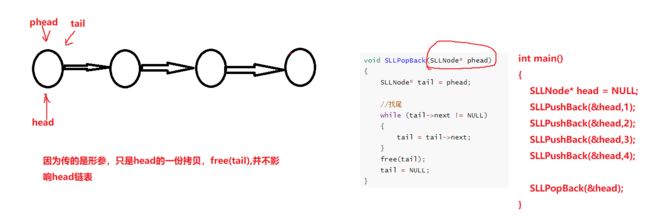无哨兵位单向非循环链表
文章目录
- 1. 认识链表
- 2. 无哨兵位单向非循环链表结构
- 3. 生成一个结点
- 4. 打印链表
- 5. 创建len长度的链表
- 6. 尾插
- 7. 尾删
- 8. 头插
- 9. 头删
- 10. 查找
- 11. 在pos位置之后插入数据
- 12. 在pos位置之前插入数据
- 13. 删除pos位置之后的数据
- 14. 删除pos位置数据
- 15. 销毁链表
多多关注哦,谢谢支持!
1. 认识链表
链表是一种物理存储结构上非连续、非顺序的存储结构,数据元素的逻辑顺序是通过链表中的指针链接次序实现的 。
- 和顺序表相比,链表的优势体现在哪?
顺序表中存在扩容问题,扩容扩大了,而数据没占满,则会浪费数据,链表是一个数据占一个空间,这样就不会出来空间浪费问题
2. 无哨兵位单向非循环链表结构
一个结构存放数据和关系,那么就有如下结构:
typedef int SLLDataType;
typedef struct SingleLinkListNode
{
int data; //数据
struct SingleLinkListNode* next; //指向下一个结点
}SLLNode;
3. 生成一个结点
SLLNode* BuySLLNode(SLLDataType x)
{
SLLNode* newnode = (SLLNode*)malloc(sizeof(SLLNode));
if (newnode == NULL)
{
perror("BuySLLNode:malloc:");
exit(-1);
}
newnode->data = x;
newnode->next = NULL;
return newnode;
}
- 问题一:为什么要使用malloc去申请空间,而不是用结构体类型变量?
SLLNode BuySLLnode1(SLLDataType x)
{
SLLNode newnode;
newnode.data = x;
newnode.next = NULL;
return newnode;
}
//问什么不能使用这种方式开辟结点空间?
原因:malloc申请的空间是在堆区中开辟的,堆区中的空间出了函数栈帧数据仍然存在,但是用结构类型变量,出了函数栈帧就销毁了,并不能存储数据
- 问题二:为什么开始的时候要使newnode指向NULL?
原因:在后面插入时,如果起初不指向NULL,而是指向别的地址,那么最后尾部还要对其做一步指向NULL的操作
4. 打印链表
void PrintSLLNode(SLLNode* phead)
{
SLLNode* cur = phead;
while (cur != NULL)
{
printf("%d->", cur->data);
cur = cur->next;
}
printf("NULL\n");
}
问题:为什么限制条件是cur != NULL而不是cur->next != NULL?
5. 创建len长度的链表
SLLNode* GreateSLLNode(int len)
{
SLLNode* head = NULL;
SLLNode* tail = NULL;
for (int i = 0; i < len; ++i)
{
//创建一个新结点
SLLNode* newnode = BuySLLNode(i);
//检查第一步head
if (head == NULL)
{
head = tail = newnode;
}
else
{
//变动tail
tail->next = newnode;
tail = newnode;
}
}
return head;
}
问题:为什么要区分第一步head == NULL?
新链表中返回的是头节点地址,不可能头节点为NULL吧,所以要区分,对其进行改变
6. 尾插
void SLLPushBack(SLLNode** pphead, SLLDataType x)
{
SLLNode* newnode = BuySLLNode(x);
if (*pphead == NULL)
{
//*phead拿到的是head
*pphead = newnode;
}
else
{
SLLNode* tail = *pphead;
//找尾
while (tail->next != NULL)
{
tail = tail->next;
}
//找到尾部
tail->next = newnode;
}
}
- 问题一:为什么不需要断言?
空链表也可以插入数据无需断言
- 问题二:为什么是传二级指针,而不是一级指针?
考虑传二级指针是针对*pphead == NULL时,要改变head指向的位置,改变指针所指向的位置就要传指针的指针(尾插、头插、尾删、头删都需要传二级都是这个原因)
7. 尾删
void SLLPopBack(SLLNode** pphead)
{
//写法一
assert(*pphead);
//如果结点只有一个要单独处理
if ((*pphead)->next == NULL)
{
free(*pphead);
*pphead = NULL;
}
else
{
SLLNode* pre = *pphead;
SLLNode* tail = *pphead;
//找尾
while (tail->next != NULL)
{
pre = tail;
tail = tail->next;
}
//释放
free(tail);
pre->next = NULL;
}
}
void TestSLLPopBack(SLLNode** pphead)
{
//写法二
//链表为空不能删除
assert(*pphead);
//只有一个结点的时候是不能使用的,NULL不能NULL->next
if ((*pphead)->next == NULL)
{
free(*pphead);
*pphead = NULL;
}
else
{
SLLNode* tail = *pphead;
//找尾
while (tail->next->next != NULL)
{
tail = tail->next;
}
free(tail->next);
tail->next = NULL;
}
}
问题:下面这种写法对吗?
void SLLPopBack(SLLNode* phead)
{
SLLNode* tail = phead;
//找尾
while (tail->next != NULL)
{
tail = tail->next;
}
free(tail);
tail = NULL;
}
为什么不行?
8. 头插
void SLLPushFront(SLLNode** pphead, SLLDataType x)
{
//创建结点
SLLNode* newnode = BuySLLNode(x);
//链接
newnode->next = *pphead;
//改变头结点指针位置,所以传二级指针
*pphead = newnode;
}
9. 头删
void SLLPopFront(SLLNode** pphead)
{
assert(*pphead);
//先调整头结点指针,所以传二级指针
SLLNode* next = (*pphead)->next;
free(*pphead);
*pphead = next;
}
10. 查找
SLLNode* SLLFind(SLLNode* phead, SLLDataType x)
{
//好的习惯
SLLNode* cur = phead;
//找到返回结点位置,没找到返回NULL,同时如果链表为NULL,也返回NULL
while (cur != NULL)
{
if (cur->data == x)
{
return cur;
}
cur = cur->next;
}
return NULL;
}
11. 在pos位置之后插入数据
void SLLInsertAfter(SLLNode* pos, SLLDataType x)
{
assert(pos);
写法一
//SLLNode* nextnode = pos->next;
//SLLNode* newnode = BuySLLNode(x);
//pos->next = newnode;
//newnode->next = nextnode;
//写法二
SLLNode* newnode = BuySLLNode(x);
newnode->next = pos->next;
pos->next = newnode;
}
为什么断言?
我们没找到的话就返回NULL,所以需要断言
之后插入数据为什么可以不记录pos后面的结点?
因为单链表是单向的,可以通过pos位置找到后一个结点,所以可以不用记录
12. 在pos位置之前插入数据
void SLLInsert(SLLNode** pphead, SLLNode* pos, SLLDataType x)
{
//可能是head链表不为空,但是pos为空的情况则需断言
assert(pos);
//head为空也可以插入
//head == pos时可以插入
if (*pphead == pos)
{
SLLPushFront(pphead, x);
}
//不是头部插入
else
{
SLLNode* pre = *pphead;
while (pre->next != pos)
{
pre = pre->next;
}
SLLNode* newnode = BuySLLNode(x);
pre->next = newnode;
newnode->next = pos;
}
}
为什么传二级指针?
因为链表为NULL时头插要改变head的指向
为什么这里必须记录上一个结点?
因为单链表是单向的,通过此结点不能直接访问上一个结点,所以必须记录上一个结点连接时使用
13. 删除pos位置之后的数据
void SLLEraseAfter(SLLNode* pos)
{
//断言pos,不然pos->next会有错误
assert(pos);
if (pos->next == NULL)
{
perror("warining:已经在尾部,不可对后面删除!");
}
else
{
SLLNode* nextnode = pos->next;
pos->next = nextnode->next;
free(nextnode);
}
}
为什么free后可以无需置空?
因为nextnode是局部变量,出了函数栈帧销毁
14. 删除pos位置数据
void SLLErase(SLLNode** pphead, SLLNode* pos)
{
assert(pos);
//链表为空不能删除
assert(*pphead);
if (*pphead == pos)
{
SLLPopFront(pphead);
}
else
{
SLLNode* pre = *pphead;
while (pre->next != pos)
{
pre = pre->next;
}
pre->next = pos->next;
free(pos);
//无需置空,lastnode为局部变量,出栈帧自动销毁
}
}
为什么传二级?
因为head = NULL时,要改变head指向
15. 销毁链表
void SLLDestroy(SLLNode** pphead)
{
//链表为NULL时断言
assert(*pphead);
SLLNode* cur = *pphead;
while (cur != NULL)
{
SLLNode* nextnode = cur->next;
free(cur);
cur = nextnode;
}
*pphead = NULL;
}
为什么要最后*pphead = NULL,可以不置空吗?
循环中已经对链表释放完了,但是* pphead依然指向的是头结点的位置,但是头节点的空间已经释放,还给操作系统了,这里的*pphead就是野指针,所以必须置空
重要的要点已经指出,感性大家支持!


